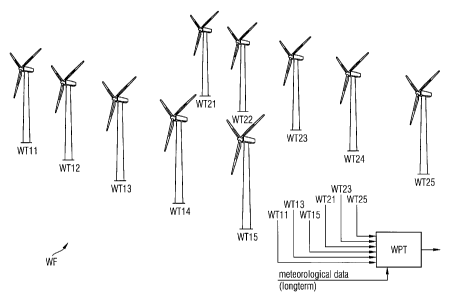Note: Claims are shown in the official language in which they were submitted.
7
claims
1. Method for the forecast of wind-resources of a wind-farm,
- where the forecast is done by a numerical weather-
prediction-tool,
- where the weather-prediction-tool uses a long-term data-
set of meteorological data, which are related to the
location of the wind-farm,
characterized in,
- that a wind-speed measurement is done by at least one
wind-turbine of the wind-farm to do a parameterization
of an atmospheric turbulence,
- that the wind-speed measurement is used to generate a
data-stream, which is combined with the data-set of the
meteorological data to do the forecast.
2. Method according to claim 1, characterized in, that the
wind-speed measurement is done continuously and in real-
time at a certain height of the wind-turbine.
3. Method according to claim 1 or 2, characterized in, that
the height of the hub of the wind-turbine is used as
certain height.
4. Method according to one of the preceding claims,
characterized in, that a number of wind-turbines of the
wind-farm perform wind-speed measurements, which
contributes to the real-time data-stream.
5. Method according to one of the preceding claims,
characterized in, that wind-speed-measurements, which are
performed at other certain heights, are used additionally
to form the data-stream.
6. Method according to claim 5, characterized in, that the
additional wind-speed-measurements are done by one or more
meteorological masts, which are located within the wind-
farm.
8
7. Method according to one of the preceding claims,
characterized in, that the temperature of the air is
measured for at least two different heights to provide an
additional meteorological information for the assessment
of atmospheric stability.
8. Method according to claim 7, characterized in, that for an
offshore wind-farm the sea temperature is measured as
additional meteorological data.
9. Method according to one of the preceding claims,
characterized in, that spatially distributed wind-turbines
are used to do the wind-speed-measurements.
10. Method according to one of the preceding claims,
characterized in, that the wind-speed-measurements and
the meteorological data are transferred to a computer-
system, to be used for modeling the numerical weather
prediction.
11. Method according to one of the preceding claims,
characterized in, that historical predictions are used
additionally to do the numerical weather prediction.
12. Method according to one of the preceding claims,
characterized in, that a predicted wind-speed is combined
with an assigned power of the wind-farm as a function to
predict a total power output of the wind-farm.
13. Method according to one of the preceding claims,
characterized in, that meteorological data and wind-
speed-measurements of a number of wind-farms are used to
do the forecast, while the wind-farms are located within
an area, for which the same numerical weather prediction
model is used.
9
14. Method according to one of the preceding claims,
characterized in, that non-wind-farm-related
meteorological measurements are used additionally to the
meteorological data and to the wind-speed-measurements to
do the forecast.
15. Method according to one of the preceding claims,
characterized in, that information from a satellite-based
wind-speed measurement are used additionally to do the
forecast.
16. Method according to one of the preceding claims,
characterized in,
- that information, which are related to the downtime of
used wind-turbines, are used additionally to do the
forecast, and/or
- that information, which are related to wind-turbines
being operated in a partly curtailed mode, are used
additionally to do the forecast.
17. Arrangement for the forecast of wind-resources of a wind-
farm, with means, which are developed to execute the
method steps according to one of the preceding claims.
